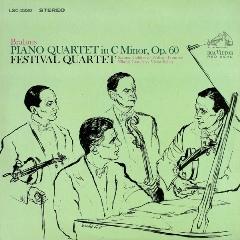Brahms - Piano Quartet No.3 in C minor, Op.60 (1964)
Brahms - Piano Quartet No.3 in C minor, Op.60 (1964)

1. Allegro non troppo 2. Scherzo. Allegro 3. Andante 4. Finale Festival Quartet: Szymon Goldberg – violin Victor Babin – piano William Primrose – viola Nikolai Graudan – cello
Brahms composed the first version of the work that would eventually become his Third Piano Quartet, Op. 60 (to which the subtitle "Werther" is often attached), in Dusseldorf in 1855-1856. The first version had emerged concurrently with first drafts for the first two piano quartets, Op. 25 and Op. 26, all received enthusiastically by his close friends, including Albert Dietrich and Joseph Joachim. At this point, No. 3 was in the key of C sharp minor. Even when (a year later) Joachim wrote to Brahms concerning the piece it still comprised three movements only, an opening Allegro, an Andante, and what Brahms' termed a "concise" finale. While its two sister works were completed in 1859 and 1861, Op. 60 was put aside, since neither Brahms nor his associates were satisfied with it. By 1869, he returned to it again and contemplated its publication as his Op. 54. But further extensive revisions followed and the quartet assumed its final shape in the winter of 1873-1874 in Vienna, with minor revisions the following summer. A letter from Brahms, sent with the manuscript to Theodor Billroth includes the following enigmatic comment: "the quartet has communicated itself to me only in the strangest ways...For instance, the illustration to the last chapter of the man in the blue frock and yellow waistcoat." This refers, somewhat obliquely, to Goethe's Werther, which Brahms admired. Meanwhile, he remained deeply dissatisfied with the work, and wrote to his publisher Fritz Simrock "you may attach a picture on the title page, i.e. a head with the pistol before it."
The definitive version is comprised of the 1855-1856 score's opening movement, a scherzo from 1856-1861, and an Andante and finale (allegro commodo) from 1875. The work, now in the general key of C minor, reflects the turbulent and vacillating self-doubts that Brahms felt so deeply. Indeed, little more darkly oppressive movements than the first exist anywhere else in Brahms' chamber output, while the "new" andante in E major is certainly one of the most beautiful. Above all, however, the work fully deserves its Goethe connections, for neither Brahms nor Werther enjoyed a contented course en route to their respective destinies.
The C minor Piano Quartet was first performed in Vienna on November 18, 1875, with Brahms himself at the piano, and members of the Hellmesberger Quartet. --- Michael Jameson, Rovi
download (mp3 @320 kbs):
uploaded yandex 4shared mega mediafire zalivalka cloudmailru oboom uplea








